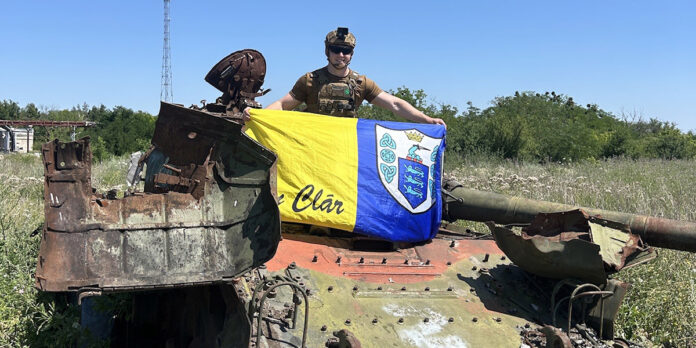On a sunny August afternoon, while many of his college friends were lying on some beach or relaxing on a foreign holiday, Doonbeg medical student, Oran McInerney, was two tenths of a second from a massacre.
He was in the middle of a firing range in eastern Ukraine, training locals in basic first aid, when a cluster munition fired from a Russian fighter jet fell from the sky and almost literally hit him on the head.
What happened next was chaos.
Cluster bombs are vicious killers. On detonation, the bombs divide into dozens of smaller munitions and kill brutally and indiscriminately. But cluster bombs also fire forward, and on that fateful day, the Russian pilot pressed the detonator a fraction of a second too late, raining terror on the land just behind Oran and the people he was training.
Earlier this month Oran returned from his third humanitarian tour in Ukraine. His first trip was in April of 2023 with the Road to Relief humanitarian organisation. On that trip his work involved supplying civilians close to the front line, including dropping off wood burning stoves to Bakhmut, days before the devastated city fell to the Russians.
After his return home, Oran learned that the founder of that charity was killed by a Russian anti-tank missile.
His second trip, in August of 2023, was with the Stop the War organisation, which provides basic medical training to new army recruits and civilians.
This year he spent three months practicing medicine in a bunker with Front Line Medics, a non-government organisation which treats and transports injured soldiers from the front line.
Over the course of these humanitarian trips to Ukraine, Oran has been close to death on a number of occasions, but never as close as during the cluster attack in eastern Ukraine.
“The cluster fell near my head. Cluster munitions shoot forward, and this bomb missed our group by maybe 200 metres. The only reason that he didn’t hit us was that he pushed the button a fraction of a second too late,” he told The Clare Champion.
“We didn’t see the fighter plane, it was travelling too fast. We were on a firing range at the time so we were used to all of these explosions around us.
“We all just ran. I remember just running through a forest and then being evacuated. It was insane.
“The unit we were training at the time, unfortunately, I got word that a lot of them have been killed and wounded. The casualty rate is horrific at the moment, and you just don’t hear about it over here [in Ireland].”
This summer’s posting with Front Line Medics has brought Oran closer to the front line of the war than ever before.
“We worked either 24hours on, 24 hours off, or 48 hours on, 48hours off. First we were living in an abandoned house, but then we got some intelligence that the Russians were going to try and target us, so we moved to a bunker,” he said.
“Even though you are an ambulance, the Russians will still try and target you.
“I lived in that bunker for about three months.
“We lived with a Ukrainian team who would go out in their MM13 tank, right onto the front line to collect a casualty. They only operated at night, because of the drones.
“You can’t move during the day. Any bit of movement and an FPV drone will get you. The FPVs are about the size of a bird and the person flying it will try to fly it into you and blow your arm or leg off, or it could easily destroy our ambulance. I’d say that 80% of the injuries that we were dealing with were from drones.
“You have drone jammers, but they need to be on the right frequency. You might have ten drone jammers but if you mess up one frequency it [the drone] will get you.
“As well as the FPVs there are drones that drop grenades on you, huge drones that take out tanks, surveillance drones above us all the time, grad bombs, glide bombs, ballistic missiles, artillery shells.
“We would normally get about 30 minutes of a warning before casualties arrive. It could be one injured, or five or ten.
“You might have serious injuries or less serious stuff like concussions. There was a lot of concussions from explosions going off very close to soldiers. A lot of people had shrapnel injuries, which are tiny pieces of metal which fly through you, in and out.
“We can only operate at night, so if a soldier gets injured in the morning, are they going to survive until the night? If you get injured at 10am, you might have to wait 12 or 14 hours to be evacuated.
“Casualties are evacuated from the front line and they are driven to a stabilisation point about 10 to 20 kilometres away from the front line, they are dragged off the pick-up truck or sometimes a tank and they are taken to the stabilisation point where there is usually a surgeon and a lot of medics who try to keep them alive until they can reach the nearest hospital.
“Once the casualty gets to us, we stabilise them and give them pain medication. The hospital that we were bringing them to was constantly being targeting by glide bombs, which are launched from Russian airspace and glide 70 or 80 kilometres. It is very difficult to stop these bombs, Ukraine is being decimated by them.
“They have been trying to hit the hospital for months, but if they miss the hospital, they take out the local shop or people’s homes.
“We had a lovely pastry shop close to the hospital where several women worked, that was hit. A supermarket was destroyed. So many houses around the hospital have been decimated. A lot of people still live in this town.
“With a glide bomb you get no whistle [warning noise], you just hear the explosion. I remember we were dropping off one patient and we heard a huge explosion which shook the whole place. They missed us by a few hundred metres.”
In the 30 months since the Russian invasion of Ukraine, the local population in the east of the country has been devastated. With so many civilians now defending their country from invasion, Oran believes that there is now little difference between the people of Ukraine and the Ukrainian army.
“So many people have been killed and so many people have joined the army that all the civilians are essentially the military. You have farmers, IT workers, artists, paramedics, every walk of life is now in the military,” he said.
“You ask them when they joined the military and they have been there for two months, four months or a week. At this stage, helping the civilians of Ukraine is helping the military.
“I remember on my first trip to Ukraine [with Road to Relief ] I did a lot of humanitarian work, delivering food, we delivered a lot of wood burning stoves to Bakhmut just before it fell, that sort of stuff.
“I remember we had women coming out of their houses crying and hugging us, saying their windows had been taken out by grad missiles.
“They are all living off the land, they had no money. They gave us fresh goats milk, goats cheese and bread. They gave us homemade wine that tasted like Buckfast, which was funny. I don’t know what happened to them, I hope they are still alive.
“Volunteers are a constant target, it doesn’t matter what clothes [medical uniform] you are wearing.
“You will get taken out and you will be killed. Anything that moves is a target unfortunately.”
Andrew Hamilton is a journalist, investigative reporter and podcaster who has been working in the media in Ireland for the past 20 years. His areas of special interest include the environment, mental health and politics.



